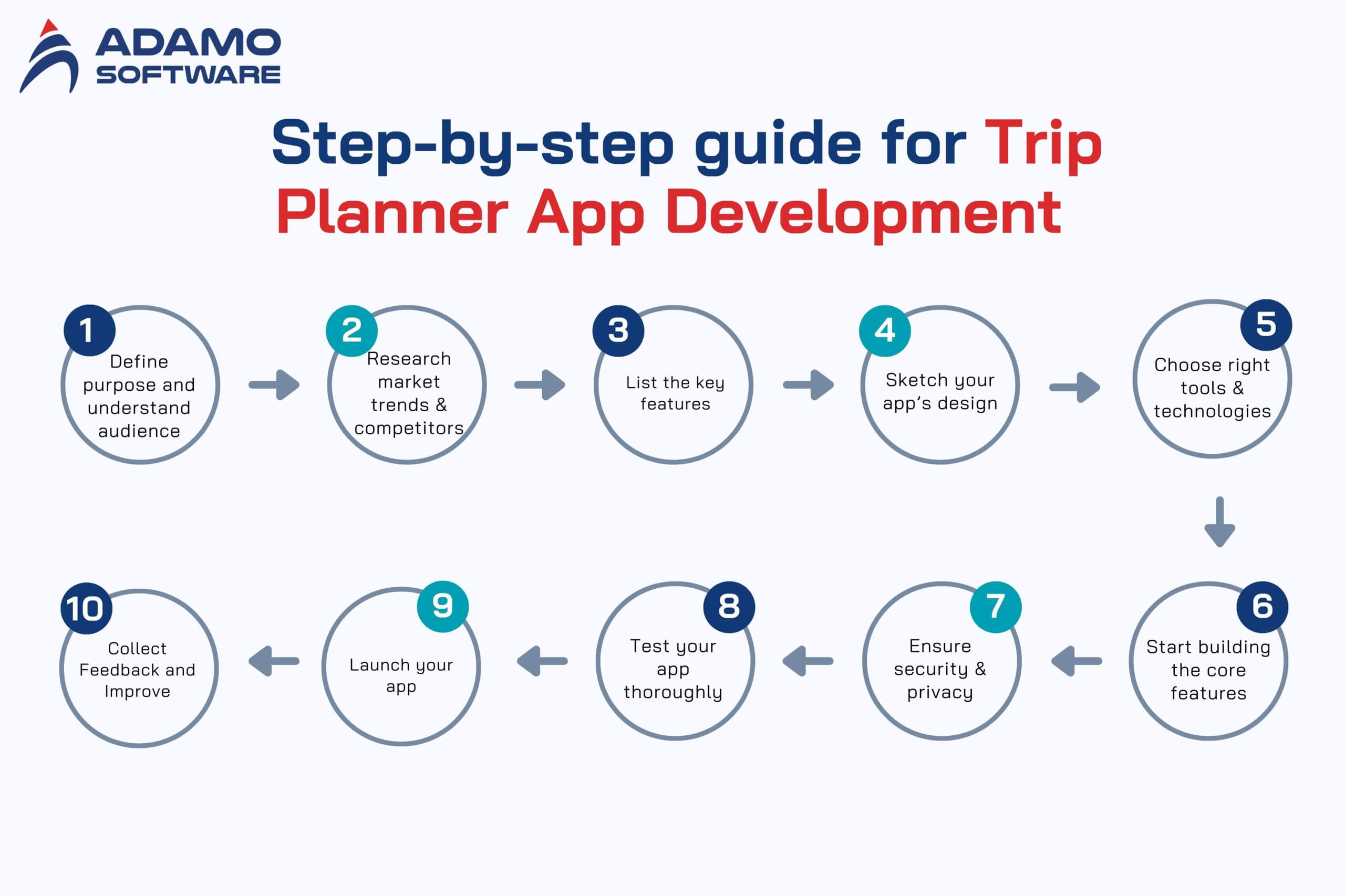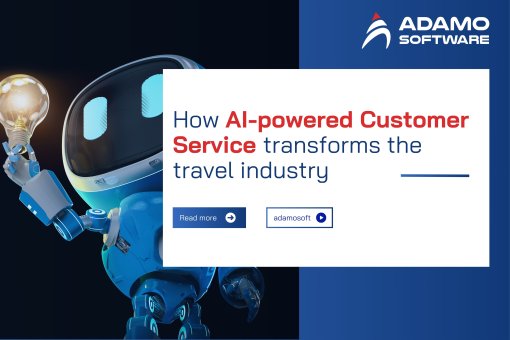Trip Planner App in 2026: Must-Have Features, Costs & Development Guide

Vacation planning is always exciting but can be a major project by anyone’s standards. Starting from searching for locations to choosing hotels or arranging a schedule, the process can turn into a real hustle. That is why using a trip planner app can be so helpful at this point. A trip planner app assists you in organizing the entire trip in one single place.
As travel becomes more common, locals and tourists are increasingly utilizing travel applications to minimize planning time and encompass a stress-free vacationing experience. However, these apps have basic functionalities with aids that help the users from the initial stage to the end. Whether you are planning your apps or a development team member, these products are worth learning.
In this article, you will learn what a trip planner app is, its features, the individual steps involved in development, and its expenses. Moreover, we will discuss how cooperation with Adamo can be the perfect decision for realizing your trip planner app idea.
I. What is a Trip Planner App?
A trip planner app assists users in scheduling and planning their travel Itinerary. It offers an instance where the user can generate specific schedules, arrange for transport, secure lodgings, and get leads to other activities in the journey.
The trip planner app solves the organizing problem. This helps users to conveniently deal with all matters in one location. These are the purposes of apps meant to minimize the expenses of time and stress. It ensures that any info any traveler would require is available.
A trip planner app also has an added feature of allowing users to filter their plans depending on factors. They are budget, destination, or date of travel. This makes the app of significant utility for the casual traveler and the complicated one.
In other words, the trip planner app is one of those inevitable needs that people with extensive travel plans should consider using.
II. The increasing demand for trip itinerary planner apps
The needs of the modern traveler have expanded, leading to the high demand for trip planner apps. As the various social elements advance, clients want perfect service solutions for organizing travels to various destinations. A trip planner app consolidates all travel-related information, such as bookings and itineraries, into a single application.
However, one of the primary factors is a tendency toward individual tourism. People do not travel to receive anonymous service any longer. But they search for trips based on their needs, activities, preferred destinations, and other suggestions. A trip planner app helps the users to tweak the details. It guarantees that one gets to have an appealing experience.
Also, the travel industry has recorded a more significant increase in last-minute and impulse travel. In such situations, a trip planner app is a perfect one. Users can easily find solutions without stress. Options like real-time updates, on-the-spot booking, and personalized recommendations are a necessity for these apps.
There have been changes in work life, a global shift towards remote work, and a rise in the work-from-home culture. The trend of digital nomadism has urged the demand for trip planner apps. Considering the trend where individuals can work from one country to another, they need tools that assist them in organizing their schedules and traveling.
In sum, consumers are soon going to demand the availability of trip planner apps. The reason is that society has become too vast and large to travel without needing direction. They offer efficiency, freedom, and customization and, therefore, are useful for anyone who likes to travel.
You can deep dive into trip managment software here.
III. Must-have features in successful trip planner apps
The key points that should be implemented into the framework of an efficient trip planner app are convenient and effective tools for organizing the trip. It must be useful for all travelers types. These features make planning easier and more fun in the overall journey. The following are the features every trip planner app must have:

1. User-Friendly Interface
A trip planner app should have a GUI interface that is user-friendly even for first-instance users. Plain menus, a structured design, and discernable buttons are imperative. A user interface should enable users to avoid spending their time on how to navigate through the app. Effective interaction can also be greatly channeled in an efficient trip planner app to increase its relevance in the users’ travel activities.
2. Itinerary Creation and Management
The most important feature of any trip planner app is the possibility of creating and organizing itineraries. It means that users should be able to enter the travel information in a structured manner including the place to travel, dates, activities to be conducted, and the mode of transport. There must not be issues when making changes to an event within this application, for instance, adding or deleting events. It transforms a simple mobile application that provides a combination of flexible itinerary planning and decision-making into a travel essential.
3. Booking Integration
A trip planner app should be capable of connecting with booking apps so that when a user books a flight, accommodation, car, and activity, they can do it directly from the app. This feature helps in avoiding the use of many websites thus taking time and effort. Users should also get their bookings confirmed and the changes made therein, within the app. That is why a trip planner app with this feature can be called joyful and efficient in facilitating travel planning. If you want to develop a single app for booking trip, you can consider build a trip booking software.
4. Real-Time Notifications and Updates
Notification services must be instant to ensure the recipients are updated at all times throughout the journey. A trip planner app should have notification services of flight delays, changes in weather conditions, and reservations. Furthermore, information about activities to be done helps those on travel not to lag in their schedule. It is a feature that assists in nurturing confidence and reliability and that is why the trip planner app is always recommended in a journey.
5. Budget Management
Most people need to budget and therefore should have a way to do so in a trip planner application. Users can constrain a trip budget and monitor the costs of accommodation, food, and entertainment. This is because such an app should entail clear divisions on the expenditures to enhance resource control among users. A trip planner app with this feature is suitable for travelers of all classes, both the low and the high end.
6. Offline Access
A reliable trip planner app should offer offline access to important information, such as itineraries, maps, and tickets. Travelers often face connectivity issues during their trips, so offline access ensures they can retrieve essential details anytime, anywhere. This feature is a must-have for any trip planner app aiming to provide a seamless user experience.
7. Maps and Navigation
An integrated map and navigation system is a critical feature of any trip planner app. Users should be able to explore destinations, find nearby attractions, and get directions with ease. The map should include landmarks, restaurants, and hotels to enhance the user’s travel experience. A trip planner app with advanced navigation ensures users never feel lost.
8. Collaboration Features
For group travelers, collaboration features are indispensable. A trip planner app should allow users to share itineraries, assign tasks, and make plans together. Features like group chats and shared calendars help users coordinate efficiently. By offering collaboration tools, a trip planner app becomes ideal for families, friends, or work teams traveling together.
9. Personalized Recommendations
Travelers appreciate suggestions tailored to their preferences, and a trip planner app should provide personalized recommendations. These can include popular attractions, hidden gems, restaurants, or local activities. Based on user interests, the trip planner app can offer unique options that make the trip more memorable.
You can explore how Travel Itinerary Software streamlines travel industry here.
10. Security and Data Privacy
Travelers must have their security and privacy needs met when using a trip planner application. Aspects such as safe and secure means of payment confirm that user information is safe. Consumers have to rely on the fact that their identity, and their financial information, are protected while using the trip planner app. It succeeds in establishing confidence and promotes additional application.
By doing so, an incorporation of these features makes a trip planner app an end-to-end solution capable of satisfying the needs of travelers. Such elements let the app populate the market and satisfy different needs of users at the same time. The goal of a perfect trip planner app is that the planning of the trip should be as much fun as the trip itself.
IV. Step-by-step guide for trip planner app development
Constructing a trip planner application may appear challenging if you scored your first trip as an application developer. Still, when it’s elaborated with the right methodology, it is quite doable. Here is a detailed guide with simple steps to assist a beginner in designing a perfect trip planner app that will be effective.

1. Define the Purpose and Understand the Audience
Before you start building your trip planner app, ask yourself these questions:
- What problem will the app solve?
- Who will use it (solo travelers, families, group travelers, or business travelers)?
- What will make your app unique compared to other apps?
For example, if your audience is families, then your app would have sections such as family activities. Understanding your audience makes it easy to develop a trip planner app that effectively accommodates all user needs.
2. Research Market Trends and Competitors
Research is needed on successful mobile trip planner applications similar to TripIt or Wanderlog. Install these applications, trial these services, and determine the pros and cons. Anytime you are dealing with competition look at their portfolio and try to find any blind spots that you could exploit.
For example:
- Are they missing collaboration tools for group trips?
- Do they make it difficult to manage budgets?
There are some opportunities that your trip planner app can fill and innovations that it can add to have a competitive edge.
3. List the Key Features Your App Will Offer
To make a great trip planner app, include the following features:
- Itinerary Creation: Let the users input travel dates, their preferred destinations, and activities in a planned sequence.
- Booking Integration: Users can easily book flight, hotel, and car rentals within the application at a convenient price.
- Offline Access: Stay is required for the users to be able to view their travel plans and maps offline.
- Budget Tracking: Provide resources for tracking expenses and ensuring that the expenses will not go beyond their set budget.
- Maps and Navigation: Adapted to point out the routes to trace, restaurants, and attractions nearby.
Make a list of these features and find out which one of them you want to implement in your first version of the app, known as MVP.
4. Sketch Your App’s Design (Wireframing)
Wireframing is the process of going through and producing a rough drawing of how your app will be like when done. If you are not a designer, do not worry; you only need to imagine the way it will be laid.
- Start Simple: Illustrate a home page including a checklist such as “New Trip Planning” or “My Itinerary.”
- Map Out the Navigation: This is quite important to make sure the user transitions from one page. For instance, the home page to the itinerary page is smooth.
Website flow and wireframing your trip planner application can be created anywhere using Figma or even a piece of paper and a pencil.
5. Choose the Right Tools and Technologies
More often than not, you may attend as a total novice, or you may need to learn or work with developers. Here’s what you need:
- Front-End: This is what the user sees and can, in one way or another, engage with. It is developed using frameworks such as React Native or Flutter.
- Back-End: This is the nucleus of the organization where all the information is managed and archived. The popular ones are Node.js or Python.
- Database: Maintain the user data and destinations and bookings using tools such as Firebase or MySQL.
You can try using app-building platforms like Adalo or Bubble should you still not be willing to code everything on your own.
6. Start Building the Core Features
Do not attempt to cram as many functions as possible into your trip planner app, instead, concentrate on the main functions.
- Itinerary Manager: They should be able to add information about travel such as destinations, dates, and activities on a particular part of the website.
- Booking Integration: Link your app to booking platforms such as Booking.com, for accommodation and Expedia for flight bookings.
- Maps and Directions: It should provide tools such as Google Map API to enable users to get to their desired location.
Begin by adding as few features as possible and guarantee optimization before adding others.
7. Ensure Security and Privacy
If people like using your trip planner app, then they will provide personal and payment information –which should be secure.
- Data Encryption: Prevent unauthorized access to a user’s data, accompanying the travel itinerary and payment information.
- Secure Payments: E.g., to use the payment methods that can be relied upon, such as Stripe or PayPal.
That is why if the users feel safe using your app, they will recommend it to others.
8. Test Your App Thoroughly
This is why you should test your trip planner app before you launch it so that you can address any distinct glitches and optimize the performance.
- Functional Testing: Ensure all booking tools and changes to the itinerary are functional correctly.
- Usability Testing: It’s strict and says that a small group of users should be asked to use the application. Their actions should be observed to notice that they find it difficult to perform some operations.
- Device Testing: Check your app on different active phones, tablets, and operating systems to ensure it is friendly to all.
Testing helps your trip planner application be accurate, efficient, and a great one.
9. Launch Your App
After the app has been refined and completed, just publish it to a platform: Google Play Store or App Store.
- Describe the features of the trip planner app to distinguish it from the competition.
- Or post it on social networks, traveling blogs, and forums where people can find others like themselves. Action, so security is crucial.
10. Collect Feedback and Improve
Once the application is running, read users’ comments to define what changes should be made.
- Incorporate options for extra revenue upon customers’ demands like more options for booking or quicker site search.
- Address any reported issues that have a bug or make the system and the application crash.
These challenges are related to the effectiveness of the application and keeping the trip planner application relevant for travelers.
As observed, implementing the above steps in the process of developing and designing the trip planner app. This makes it easy for even a beginner to develop an app that executes the needs of the users appropriately. By having a strategic plan on how the development process is going to be done and the way it is going to be executed, your app will one day be relied upon by travelers around the world.
V. How much does trip planner app development cost?
The factors that define the trip planner app development from a cost perspective include the following. These factors must be known to estimate the budget suitably. Though the above factors are crucial for determining current consumption expenditure, it is even more important to understand them for a suitable budget. The cost is not fixed and may depend on the complexity, the number of features provided in the app, the appearance and design, and the qualifications of the working team. To enable you to understand what affects the cost of developing a trip planner app, here is a soil analysis.
1. App Complexity and Features
As a result, if you want an application to have more advanced features you will incur more costs. More specifically, simple apps that include only a few functions, such as scheduling and mapping, are cheaper. However, if you want to have some extra options, – integration with a booking system, notifications in real-time, and offline mode – the price will be higher. Forming additional elements such as applying budgeting or group communication functions also increases the price.
2. Design and User Experience (UX)
The usability aspect is crucial in the case of a trip planner application that will be cheaper than custom designs that reflect the needs of the application. A good GUI will make customers find your application easy and fun to use, but it will need more designers which are more expensive.
3. Platform Selection
The specific OS for your trip planner app, Android, iOS, or both also influences the cost.
- It is cheaper to develop one platform because it only consumes resources once.
- If you want both versions, they will come at a higher price and they will consume more time to develop.
Flutter kind of solutions can save you costs due to the creation of a single app for both platforms simultaneously.
4. Development Team and Location
The cost of hiring a development team depends on the location and experience of the team, and its required expertise.
- Freelancers: Pricing can be lower but sometimes may not have the solidity of the dedicated team.
- In-House Team: It provides complete control usually, costs can be high due to wages, and other overhead expenses.
- Outsourcing: Some said that many companies outsource to regions where development costs are lower, like Eastern Europe or Asia. Sometimes the compliance team itself provides an affordable outsourcing service with high quality.
For instance, hiring developers from the US or Western Europe may be expensive at $100–$200 per hour. Developers from Eastern Europe and India between $30–$80 per hour.
5. Maintenance and Updates
Expenses related to a trip planner app do not only stop at development but are recurrent. Periodical updates, upgrades, and patches are essential to make the app run smoothly and stand its ground.
- Simple changes and nominal repair works may cost a few hundred dollars every month.
- Since adding new features will be considered as creating a whole new application or a major update, it would entail additional cost.
Estimated Costs
To give you a rough idea:
- Basic Trip Planner App: $20,000–$40,000
- Moderately Complex App: $40,000–$80,000
- Advanced App with Unique Features: $80,000–$150,000 or more
The actual cost will depend on the specific requirements of your trip planner app and the team you choose to work with.
6. How to Optimize Costs
To keep costs manageable:
- Start with a Minimum Viable Product (MVP) that includes only essential features.
- Choose an experienced yet cost-effective development team.
- Use pre-built tools or APIs for features like maps or bookings to save development time.
Creating a trip planner app is not cheap. However, it must be noted that even building a premium app is quite possible if a company employs the right people.
VI. Why should choose Adamo as the ideal partner for your Trip Planner App idea

Adamo Software is a reliable company specializing in travel and hospitality software development among which there are unique and high-quality products. Our seasoned developers and strategists help make your trip planner app unique in a competitive world with years of experience. We help you to understand what you want and transform your dream into a superb app, not only digital transformation but even AI trip planner app.
Adamo focuses on generating professional and effective software products that serve the purpose needed and have a pleasing design. We utilize the applicable technologies to create efficient and functional trip planner applications. Don’t hesitate to contact Adamo to discuss our itinerary management, booking integration, or even a budgeting app tailored to your needs.
Why Adamo – We are a partner who appreciates creating quality and maximum effectiveness. They have vast experience in app development and their customer-centric approach makes them suitable to help you develop your trip planner app idea.
FAQs
1. What makes travel planner apps superior to other conventional means of trip planning?
Travel planner apps are superior because the customer is privileged to get convenience and organization all under one application. This is in contrast to paper or online versions, which may require multiple documents or sources. A trip planner contains all the relevant information—from the plan for the vacation to the bookings and documents—in one place. This will be of enormous convenience to travelers, especially when organizing their travels and monitoring the different trips they might be undertaking.
2. Do travel planning applications only manage lodging and flights, or do they offer additional functions to enhance the trip experience?
It depends on the available trip planner app that is adopted. Some apps also offer end-to-end services, such as Wanderlog, which covers lodging, flights, tours and activities, and local experiences as well. While some apps, like Trip It, primarily focus on travel planning, they also offer a variety of other services. Of course, you should select a trip planner app that best suits you.
3. Do travel planning apps facilitate group travel by enabling the sharing and coordination of itineraries among multiple users?
Many apps have social features so you can see friends and family and share the trip planner. This eases planning a group trip, as everyone can always check the current status of affairs. Another feature is sharing the trip details on social networks. This contributes to sharing experiences in these applications.
4. Is it necessary to integrate the travel app with a payment gateway?
While it’s not mandatory for a trip navigation app to have a payment option, many do so for convenience. Some apps include such services as a booking engine or an external hotel service since users can book through them. Discuss the payment gateway with your developers if you plan to integrate restaurant booking into the app’s functionality.
5. Can a trip planner app help users manage their travel expenses?
Indeed, regarding trip planner applications, many of them provide functionalities for budgeting the estimated cost of the trip. Tasks such as breaking costs, tracking expenses, and setting up daily/monthly/annual budgets for traveling activities, food, and accommodation are some of the features that are expected. This helps travelers keep to their cost limit all the way through. At the same time, it aids them in having a smooth-running trip.
6. Is travel technology integration useful for reducing manual work in trip planning?
Yes, travel technology integration is very useful because it automates most manual tasks in trip planning. It connects tools like booking platforms, AI trip planners, and expense trackers to organize flights, hotels, and activities in one place. This saves time, reduces errors, and makes planning smoother—especially for families managing multiple bookings and budgets.
7. How do travel news services integrate with itinerary management tools?
Travel news services connect with itinerary tools through APIs to deliver real-time updates like flight delays, weather alerts, or regional advisories. When connected, itinerary tools like TripIt, Travelfy, or TripCase can automatically match a traveler’s schedule with external news data. For example, if a storm affects your destination, the tool sends a notification, adjusts the itinerary timeline, and may even suggest alternate flights or hotel options.
This integration reduces manual monitoring, improves trip safety, and ensures travelers can make informed decisions quickly. In short, travel news feeds and itinerary management systems work together to transform static itineraries into dynamic, real-time travel companions.











